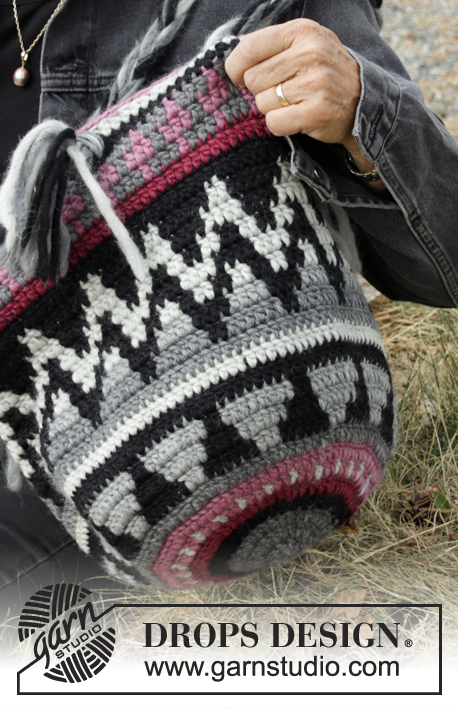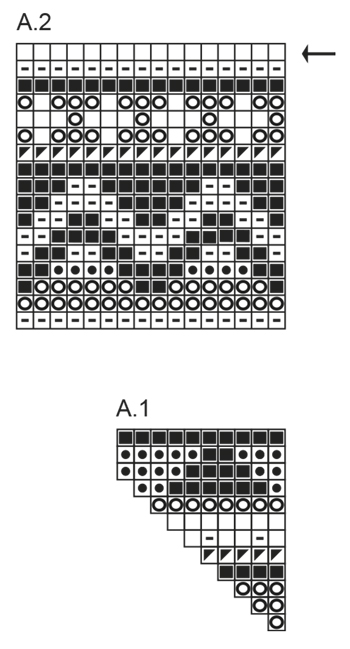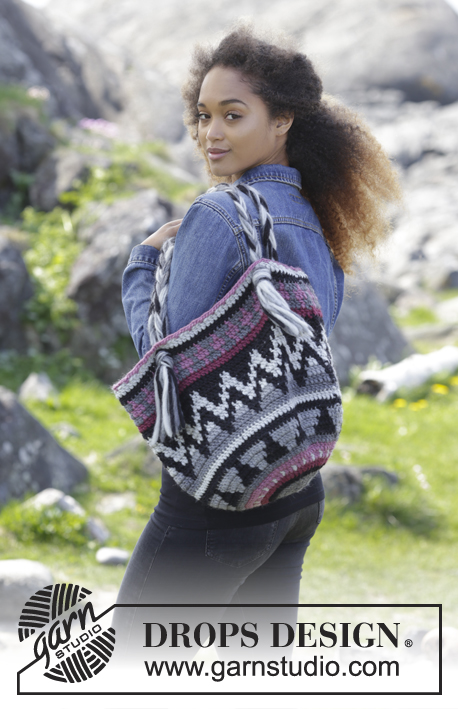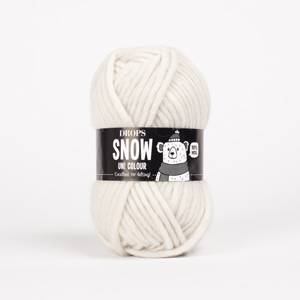Comments / Questions (5)
![]() Ieta Van Leeuwen wrote:
Ieta Van Leeuwen wrote:
Dank voor het prachtige patroon \r\nMijn vraag gaat over het uitprinten van het patroon \r\nAls ik het patroon uitprint \r\nGaat de bovenste foto over de tekst met benodigdheden \r\nDat is ook bij andere patronen van Drops \r\nIk print vanaf mijn iPad altijd gedaan en eerder nooit geen last er van \r\nAlleen de laatste tijd \r\nGr Ieta
20.06.2019 - 14:15DROPS Design answered:
Dag Ieta,
Dat is vervelend. Ik zal je probleem rapporteren, zodat er gekeken kan worden of er technische problemen zijn. Wat je in de tussentijd zou kunnen doen is eerst het patroon als pdf opslaan (bij je afdrukopties) en daarna de pdf afdrukken.
20.06.2019 - 19:36
![]() Vámos Károlyné Hajni wrote:
Vámos Károlyné Hajni wrote:
Kedves Drops Design, Tudnának segíteni? Sajnos az előző rögzítésre nem kaptam választ. Amelyik sorban csak egy szín van, ott melyik színt kell vezetni? Válaszukat előre is köszönöm. Üdv, Hajni
29.10.2018 - 19:51DROPS Design answered:
Kedves Hajni, abban a sorban, ahol csak egy szín van nem feltétlenül szükséges a nem használt szín(eke)t vezetni. ezekben a sorokban elég egy színnel horgolni. Kérdéseire közvetlen választ is kaphat a Facebookon a Magyar Drops csoportban. Sikeres Kézimunkázást!
30.10.2018 - 03:27
![]() Anna wrote:
Anna wrote:
I adore this mature and beautiful model --> she\'s a breath of fresh air
27.09.2018 - 17:48
![]() Hajnalka Vámos Károlyné wrote:
Hajnalka Vámos Károlyné wrote:
Szeretném megkérdezni, hogy minden színt folyamatosan vinni kell minden sorban akkor is, ha az adott szin abban a sorban nincs használva? Azaz mindig 5 fonalszálat kell körbe hurkolni? Ha nem így van, nem lesz egyenetlen a vastagság? Előre is köszönöm a segítséget. Üdv, Hajni
13.09.2018 - 23:43DROPS Design answered:
Kedves Hajni! Köszönjük a kérdést. Mindig csak azt a két színt kell körbe vinni, amit az adott sorban használunk. Mivel minden sorban mindig csak két szín fut, így, ha az éppen nem használt színt horgoljuk körbe, a horgolás vastagsága egyenletes marad. Sikeres kézimunkázást!
30.09.2018 - 09:07
![]() Stefani wrote:
Stefani wrote:
Made the other similar bag and I love the patterned crochet, it is so much fun to make!
07.06.2017 - 04:25
Pueblo#pueblobag |
|||||||||||||||||||
 |
 |
||||||||||||||||||
Crochet bag with colored pattern. The piece is worked in DROPS Snow.
DROPS 179-4 |
|||||||||||||||||||
|
INFORMATION FOR THE PATTERN: PATTERN: See diagrams A.1 and A.2. 1 square = 1 double crochet. COLOR PATTERN (worked in the round): When changing color, work as follows: Work the last double crochet before the color change, but wait with the last pull through. Change to the next color and make the last pull through before working with this new color. If next round starts with a new color work the last slip stitch on the round with the new color. When working with more than one color on a round, lay the strands you are not working with over the stitches from the previous round, work around these strands so that they are hidden and carried around the piece. CROCHET INFO: The first double crochet on the round is replaced by 3 chain stitches, finish the round with 1 slip stitch in the 3rd chain stitch at the beginning of the round. DECREASE TIP: Decrease 1 double crochet by working the next 2 double crochets together as follows: Work 1 double crochet, but wait with the last pull through (= 2 loops on hook), work the next double crochet, but when working the last pull through, pull the strand through all 3 loops on the hook. ---------------------------------------------------------- BAG: The bag is worked in the round, from bottom up. Work 5 chain stitches with dark gray with hook size 4.5 mm/US 7. Form them to a ring with 1 slip stitch in the first chain stitch. Continue working in the round according to diagram A.1 (work 11 repeats of A.1 in width) – READ COLOR PATTERN! ROUND 1: Work 11 double crochets around the ring – READ CROCHET INFO! ROUND 2: Work 2 double crochets in each double crochet = 22 double crochets. ROUND 3: Work * 1 double crochet in the first double crochet, 2 double crochets in the next double crochet *, repeat *-* to end of round = 33 double crochets. ROUND 4: Work * 1 double crochet in each of the first 2 double crochets, 2 double crochets in the next double crochet*, repeat *-* to end of round = 44 double crochets. REMEMBER THE CROCHET GAUGE! ROUNDS 5-11: Continue with increases and pattern as before, i.e. each round work 1 more double crochet between the increases = 110 double crochets on the round. ROUND 12: Work the last round in A.1, AT THE SAME TIME increase 2 double crochets evenly on round (increase by working 2 double crochets in 1 double crochet) = 112 double crochets. ROUND 13: Continue working in the round, but now without increasing and according to A.2 (= 7 repeats in the round). NOTE! On the last round of A.2 (marked with arrow in diagram) do not work double crochets, work as follows with old pink: 1 chain stitch (replaces 1 single crochet), * 3 chain stitches, skip 2 double crochets and work 1 single crochet in the next double crochet*, repeat from *-* to end of round and finish with 1 slip stitch in the first chain stitch at the beginning of the round. Cut and fasten the strand. STRAPS: Cut 6 strands black, 5 strands light gray, 5 strands medium gray and 5 strands dark gray = 21 strands of 120 cm / 48". Lay the strands together and tie a loose knot, leaving approx. 12 cm / 4¾" of yarn before the knot. Divide the strands into 3 bunches with 7 strands in each bunch. Plait the 3 bunches together until there is 25 cm / 9¾" left in length. Divide the strands in 2 parts. Thread the 2 parts through the bag (from inside out) on the third round from the top, allow 1 double crochet between the parts. Tie the parts together in a knot on the outside of the bag. Pick up the knot from the beginning of the plait and fasten the end in the same way, but in the opposite side. Make another plait in the same way and fasten on the other side of the bag. |
|||||||||||||||||||
Diagram explanations |
|||||||||||||||||||
|
|||||||||||||||||||

|
|||||||||||||||||||
Have you finished this pattern?Tag your pictures with #dropspattern #pueblobag or submit them to the #dropsfan gallery. Do you need help with this pattern?You'll find 10 tutorial videos, a Comments/Questions area and more by visiting the pattern on garnstudio.com. © 1982-2025 DROPS Design A/S. We reserve all rights. This document, including all its sub-sections, has copyrights. Read more about what you can do with our patterns at the bottom of each pattern on our site. |
|||||||||||||||||||






















































Post a comment to pattern DROPS 179-4
We would love to hear what you have to say about this pattern!
If you want to leave a question, please make sure you select the correct category in the form below, to speed up the answering process. Required fields are marked *.